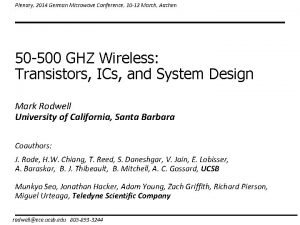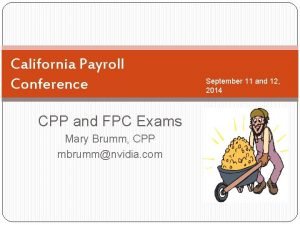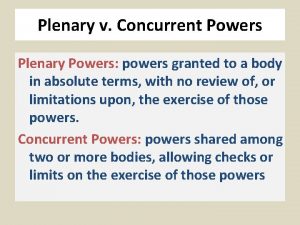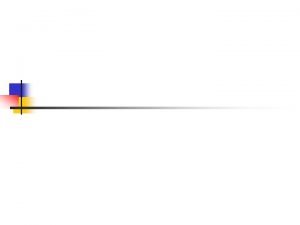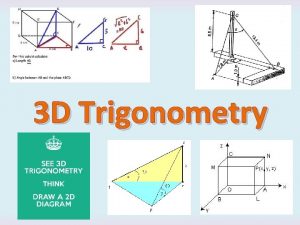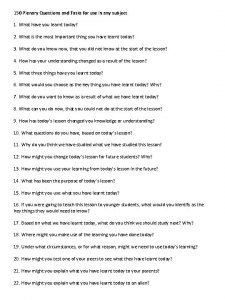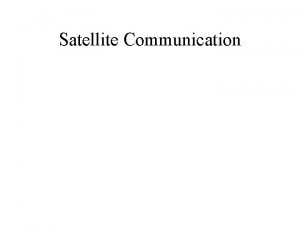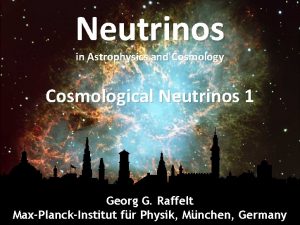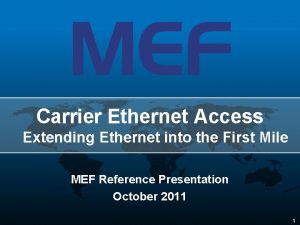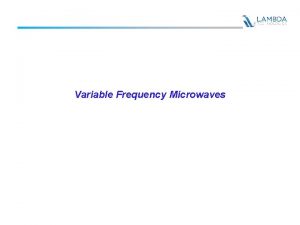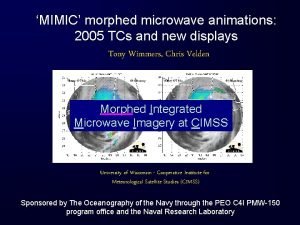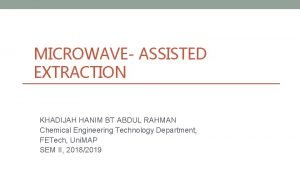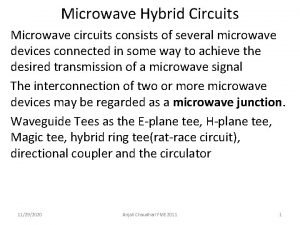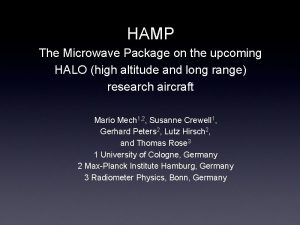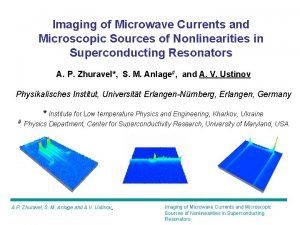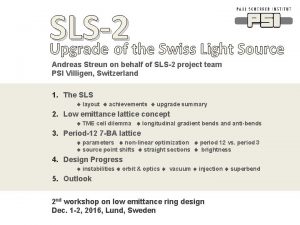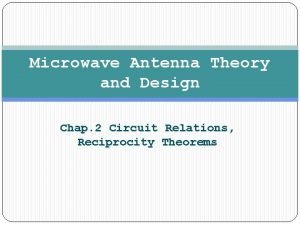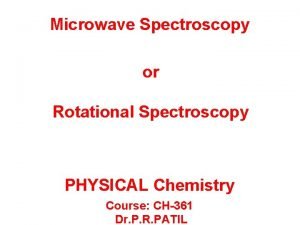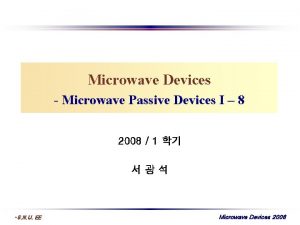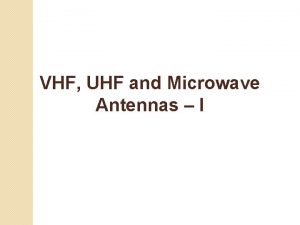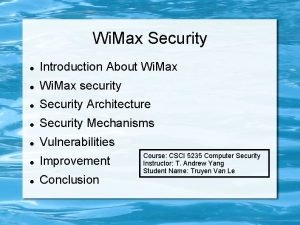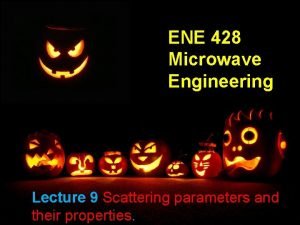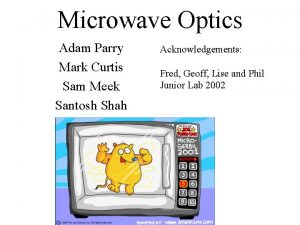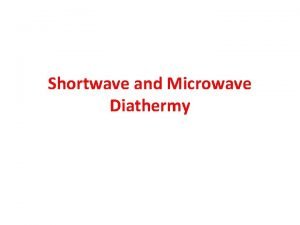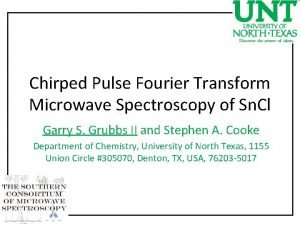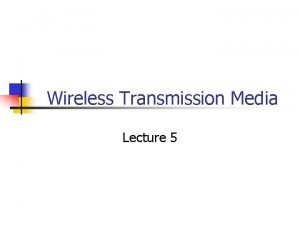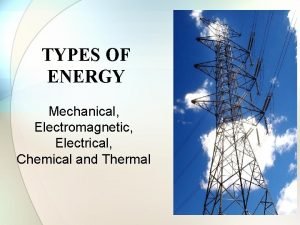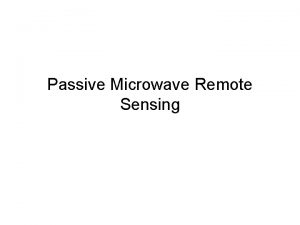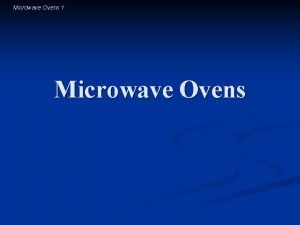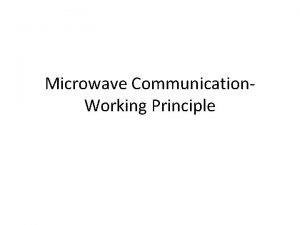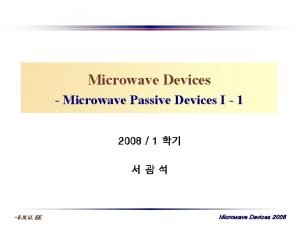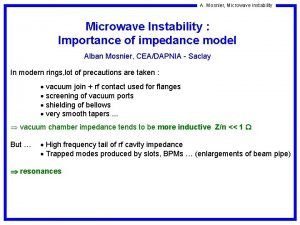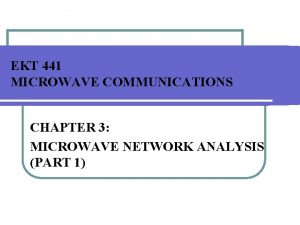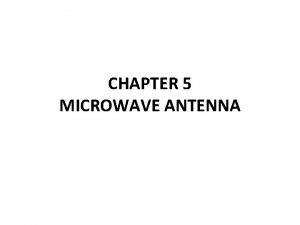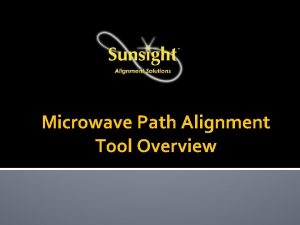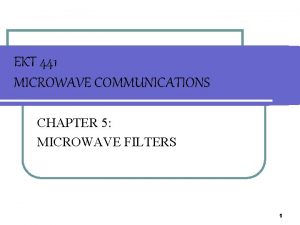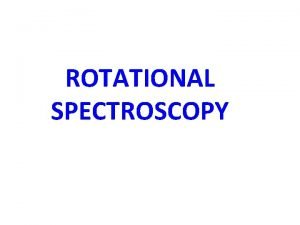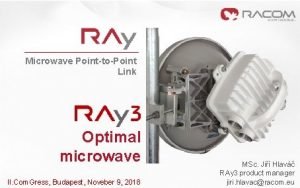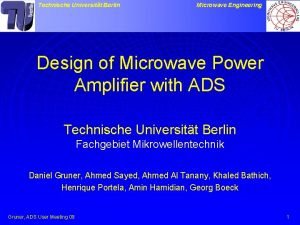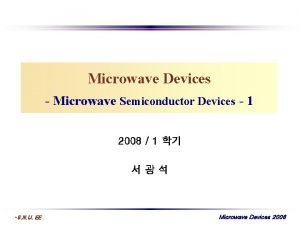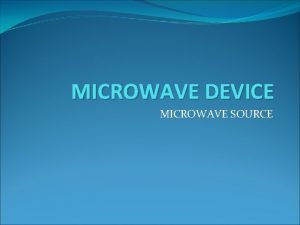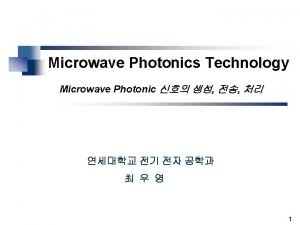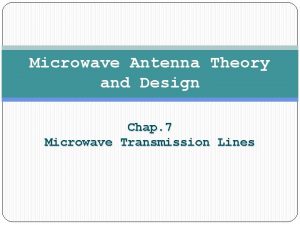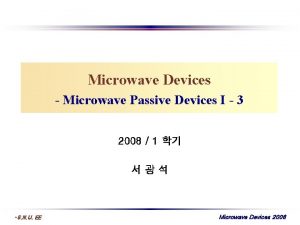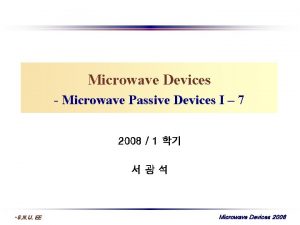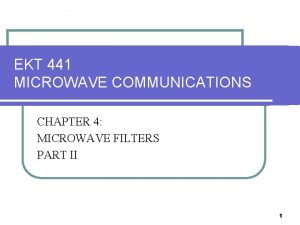Plenary 2014 German Microwave Conference 10 12 March





































- Slides: 37

Plenary, 2014 German Microwave Conference, 10 -12 March, Aachen 50 -500 GHZ Wireless: Transistors, ICs, and System Design Mark Rodwell University of California, Santa Barbara Coauthors: J. Rode, H. W. Chiang, T. Reed, S. Daneshgar, V. Jain, E. Lobisser, A. Baraskar, B. J. Thibeault, B. Mitchell, A. C. Gossard, UCSB Munkyo Seo, Jonathan Hacker, Adam Young, Zach Griffith, Richard Pierson, Miguel Urteaga, Teledyne Scientific Company rodwell@ece. ucsb. edu 805 -893 -3244

50 -500 GHz Electronics: What Is It For ? 820 GHz transistor ICs today 2 THz clearly feasible *ITU band designations ** IR bands as per ISO 20473 Applications 100+ Gb/s wireless networks Video-resolution radar → fly & drive through fog & rain near-Terabit optical fiber links

50 -500 GHz Wireless Has High Capacity very large bandwidths available short wavelengths→ many parallel channels Sheldon IMS 2009 Torkildson : IEEE Trans Wireless Comms. Dec. 2011. 3

50 -500 GHz Wireless Needs Phased Arrays isotropic antenna → weak signal →short range highly directional antenna → strong signal, but must be aimed no good for mobile must be precisely aimed →too expensive for telecom operators beam steering arrays → strong signal, steerable 32 -element array → 30 (45? ) d. B increased SN

50 -500 GHz Wireless Needs Mesh Networks Object having area ~l. R will block beam. . high-frequency signals are easily blocked. Blockage is avoided using beamsteering and mesh networks. . this is easier at high frequencies.

50 -500 GHz Wireless Has High Attenuation High Rain Attenuation High Fog Attenuation very heavy fog five-9's rain @ 50 -1000 GHz: → 30 d. B/km ~(25 d. B/km)x(frequency/500 GHz) 50 -500 GHz links must tolerate ~30 d. B/km attenuation Olsen, Rogers, Hodge, IEEE Trans Antennas & Propagation Mar 1978 Liebe, Manabe, Hufford, IEEE Trans Antennas and Propagation, Dec. 1989

mm-Waves for Terabit Mobile Communications Goal: 1 Gb/s per mobile user spatially-multiplexed mm-wave base stations

mm-Waves for Terabit Mobile Communications Goal: 1 Gb/s per mobile user spatially-multiplexed mm-wave base stations mm-wave backhaul or optical backhaul

140 GHz, 10 Gb/s Adaptive Picocell Backhaul

140 GHz, 10 Gb/s Adaptive Picocell Backhaul 350 meters range in five-9's rain Realistic packaging loss, operating & design margins PAs: 24 d. Bm Psat (per element)→ Ga. N or In. P LNAs: 4 d. B noise figure → In. P HEMT

60 GHz, 1 Tb/s Spatially-Multiplexed Base Station 2 x 64 array on each of four faces. Each face supports 128 users, 128 beams: 512 total users. Each beam: 2 Gb/s. 200 meters range in 50 mm/hr rain Realistic packaging loss, operating & design margins PAs: 20 d. Bm Pout , 26 d. Bm Psat (per element) LNAs: 3 d. B noise figure

400 GHz frequency-scanned imaging radar What your eyes see-- in fog What you would like to see What you see with X-band radar

400 GHz frequency-scanned imaging car radar

400 GHz frequency-scanned imaging car radar Range: see a football at 300 meters (10 seconds warning) in heavy fog (10 d. B SNR, 25 d. B/km, 30 cm diameter target, 10% reflectivity, 100 km/Hr) Image refresh rate: 60 Hz Resolution 64× 512 pixels Angular resolution: 0. 14 degrees Angular field of view: 9 by 73 degrees Aperture: 35 cm by 35 cm Component requirements: 50 m. W peak power/element, 3% pulse duty factor 6. 5 d. B noise figure, 5 d. B package losses 5 d. B manufacturing/aging margin

50 -500 GHz Wireless Transceiver Architecture backhaul endpoint III-V LNAs, III-V PAs → power, efficiency, noise Si CMOS beamformer→ integration scale. . . similar to today's cell phones. High antenna array gain → large array area → far too large for monolithic integration

III-V PAs and LNAs in today's wireless systems. . . http: //www. chipworks. com/blog/recentteardowns/2012/10/02/apple-iphone-5 -th

Transistors for 50 -500 GHz systems 17

THz In. P HBTs: Performance @ 130 nm Node UCSB: V. Jain et al: 2011 DRC Teledyne: M. Urteaga et al: 2011 DRC UCSB: J. Rode et al: unpublished BVCEO=4. 3 V

3 -4 THz Bipolar Transistors are Feasible. Needs: very low resistivity contacts very high current densities narrow junctions Impact: Efficient power amplifiers, complex signal processing from 100 -1000 GHz.

Ultra Low-Resistivity Refractory Contacts Baraskar et al, Journal of Applied Physics, 2013 32 nm node requirements Refractory: robust under high-current operation. Low penetration depth: ~ 1 nm. Performance sufficient for 32 nm /2. 8 THz node.

Refractory Emitter Contact and Via lowresistivity Mo contact sputtered, dry-etched W/Ti. W via Refractory metals→ high currents

Needed: Much Better Base Ohmic Contacts r e ti t em (3. 5/12/17/70 nm) ~5 nm deep Pt contact reaction u A Pd Ti Pt/Ti/Pd/Au (into 25 nm base) e s ba

Two-Step Base Contact Process 1) Blanket deposit 1 nm Pt 2) Blanket deposit 10 nm Ru (refractory) 3) Pattern deposit Ti/Au Surface not exposed to photoresist→ less surface contamination 1 nm Pt layer: 2 -3 nm surface penetration Thick Au: low metal resistance

Two-Step Base Contact Process 32 nm node requirement Increased surface doping: reduced contact resistivity, increased Auger recombination. → Surface doping spike 2 -5 nm thick. Need limited-penetration metal

"Near-Refractory" Base Ohmic Contacts

THz In. P HBTs a few more things to fix. . .

2 -3 THz Field-Effect Transistors are Feasible. 3 THz FETs realized by: Regrown low-resistivity source/drain Very thin channels, high-K dielectrics Gates scaled to 9 nm junctions Impact: Sensitive, low-noise receivers from 100 -1000 GHz. 3 d. B less noise → need 3 d. B less transmit power.

III-V MOS Development→ Benefits THz HEMTs VLSI III-V MOS THz III-V MOS: results @ 18 nm Lg

In. P HBT Integrated Circuits: 600 GHz & Beyond 340 GHz dynamic frequency divider 614 GHz fundamental VCO M. Seo, TSC / UCSB M. Seo, UCSB/TSC IMS 2010 300 GHz fundamen tal PLL M. Seo, TSC 620 GHz, 20 d. B gain amplifier M Seo, TSC IMS 2013 IMS 2011 204 GHz static frequency divider (ECL master-slave latch) 220 GHz 180 m. W power amplifier 81 GHz 470 m. W power amplifier Z. Griffith, TSC CSIC 2010 T. Reed, UCSB CSICS 2013 H-C Park UCSB IMS 2014 Integrated 300/350 G Hz Receivers M. Seo TSC : LNA/Mixer/VC O 600 GHz Integrated Transmitt er M. Seo TSC PLL + Mixer

220 GHz 180 m. W Power Amplifier (330 m. W design) 2. 3 mm x 2. 5 mm T. Reed, UCSB Z. Griffith, Teledyne 250 nm In. P HBT 30

PAs using Sub-λ/4 Baluns for Series-Combining Park et al, 2013 CSICS 80 -90 GHz Power Amplifier 17. 5 d. B Gain, >200 m. W PSAT, >30% PAE Power per unit IC die area* =307 m. W/mm 2 (pad area included) =497 m. W/mm 2 (if pad area not included) 31

to be presented, 2014 IEEE IMS:

to be presented, 2014 IEEE IMS:

50 -500 GHz Wireless Electronics Mobile communication @ 2 Gb/s per user, 1 Tb/s per base station Requires: large arrays, complex signal processing, high Pout , low Fmin VLSI beamformers VLSI equalizers III-V LNAs & PAs III-V Transistors will perform well enough for 1. 5 -2 THz systems.

(backup slides follow) 35

Effects of array size, Transmitter PAE, Receiver Fmin 200 m. W phase shifters in TRX & RCVR, 0. 1 W LNAs Large arrays: more directivity, more complex ICs Small arrays: less directivity, less complex ICs → Proper array size minimizes DC power Low transmitter PAE & high receiver noise are partially offset using arrays, but DC power, system complexity still suffer

50 -500 GHz Wireless Has Low Attenuation ? Wiltse, 1997 IEEE Int. APS Symposium, July 2 -5 d. B/km 200 -300 GHz 125 -165 GHz 75 -110 GHz Low attenuation on a sunny day
 German microwave conference
German microwave conference Anthem of poland
Anthem of poland Low german vs high german
Low german vs high german Shadow payroll spain
Shadow payroll spain Payroll conference 2014
Payroll conference 2014 Core payroll concepts
Core payroll concepts Plenary power
Plenary power Providential inspiration
Providential inspiration Pyramid plenary
Pyramid plenary Maths plenary ideas
Maths plenary ideas Genitive case meaning
Genitive case meaning Plenary questions
Plenary questions Passive microwave repeater
Passive microwave repeater Cosmic microwave background discovery
Cosmic microwave background discovery Microwave technologies for carrier ethernet services
Microwave technologies for carrier ethernet services Frequency of a microwave
Frequency of a microwave Mimic microwave
Mimic microwave Microwave assisted extraction
Microwave assisted extraction Microwave hybrid circuits
Microwave hybrid circuits Microwave device package
Microwave device package Microwave test
Microwave test Neural networks for rf and microwave design
Neural networks for rf and microwave design Thin cf flange
Thin cf flange Microwave antenna theory and design
Microwave antenna theory and design Microwave spectroscopy
Microwave spectroscopy Microwave passive devices
Microwave passive devices Domeyn pangkabatiran
Domeyn pangkabatiran Vhf uhf and microwave antennas
Vhf uhf and microwave antennas Worldwide interoperability for microwave access (wimax)
Worldwide interoperability for microwave access (wimax) Scattering matrix for a reciprocal network is:
Scattering matrix for a reciprocal network is: Microwave optics
Microwave optics Drum electrode
Drum electrode Cutoff frequency formula
Cutoff frequency formula State diagram for microwave oven
State diagram for microwave oven Chirped pulse fourier transform microwave spectroscopy
Chirped pulse fourier transform microwave spectroscopy Line of sight propagation
Line of sight propagation Microwave type of energy
Microwave type of energy Rtm-01
Rtm-01
